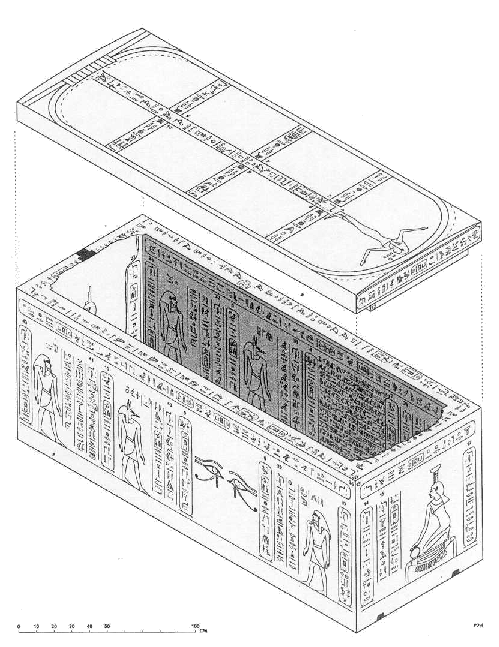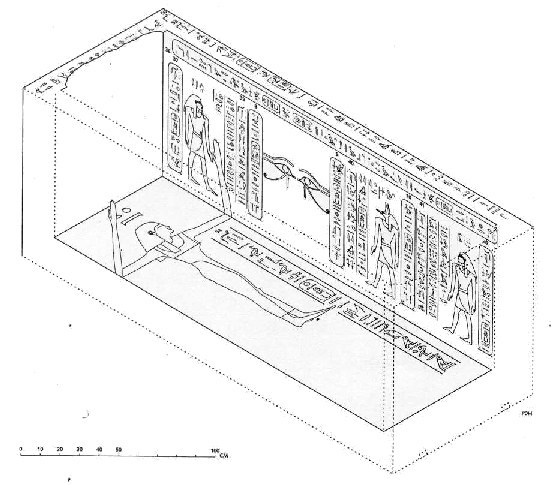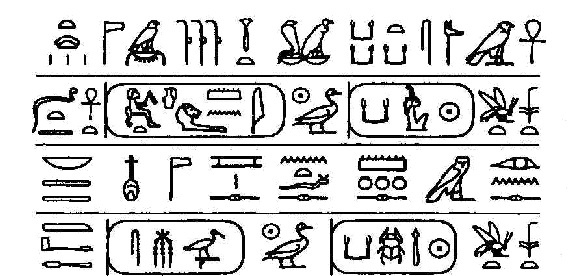|
Maat-ka-Ra Hatshepsut |
last update: 26.03.2008 |
Sarcophagus "C" from KV20
| The second sarcophagus (sarcophagus "C") built by Hatshepsut was originally prepared for her and inscribed in an appropriate way. However, when Hatshepsut planned to be buried together with her father, Thutmosis I, she left the sarcophagus for him and it was completely re-cut for him. |
| Probably, Hatshepsut had buried Thutmosis I in sarcophagus "C" in KV20. However, after seizing the power for himself Thutmosis III buried his grandfather Thutmosis I in KV38. For the burial of his grandfather in KV38 Thutmosis III provided the mummy with a new sarcophagus (listed by Hayes, 1935, as sarcophagus "E") which resembles his own (sarcophagus "F"). |
| A detailed investigation of sarcophagus "C" was presented by Der Manuelian and Loeben (1993) - comparable investigations of the two other sarcophagi built for Hatshepsut have not been done up to now. Today, sarcophagus "C" is displayed in the Museum of Fine Arts, Boston (MFA 04.278). This page gives a short summary of the investigations done by Der Manuelian and Loeben. |
| Description of Sarcophagus "C"
One solid piece of brownish quartzite was employed for the lid and and another one for the box. The base measures 225 cm in length, 82 cm in width and 76.5 to 76.9 cm in height. The lid measures 225 x 82 x 12-13 cm. The sarcophagus box weighs about 1.6 tons and the lid about 0.7 t (see also Museum of Fine Arts, Boston). |
| With exception of the long sides of the lid and the underside of the box the sarcophagus is decorated inside and outside - including the underside of the lid - with low sunk relief. This applies, as the illustration above shows, even for the top of the sarcophagus walls which were covered by the lid. The decoration is remarkably free from errors although the sarcophagus was re-cut several times. |
|
The layout of the sarcophagus reflects the fundamental Egyptian view of a
proper orientation. Therefore, the west side is associated with the
underworld and the east side with the life on earth. This associated is
also seen in specific deities depicted on the east or west side (see
below). The east side generally belongs to the sun-god and the realm of
the living, the west side shows speeches of the gods of the underworld and
the Book of the Dead.
Correspondingly, the sarcophagi were placed in the burial chamber with the head (head end of the sarcophagus showing Nephthys) facing north, the feet (foot end decorated with Isis) facing south, and the east and west sides orientated accordingly (i.e. the deceased could view "through" the udjat-eyes to the rising sun). This is the case for every sarcophagus except the two found in KV20. Both, that of Hatshepsut (sarcophagus "D") and that of Thutmosis I had been mounted facing south with their heads ends, and accordingly all other sides were erroneously facing to the opposite direction. However, this does not indicate a short break in the Egyptian funeral traditions. On the contrary, one must assume that the tomb was "treated" and equipped as if it were still running straight forward to the temple of Hatshepsut - although had to a long curve had to be carved due to the bed quality of the rock. If so then both sarcophagi were placed in conformity with the funeral traditions. |
|
According to Der Manuelian and Loeben all exteriors walls of the box, the top of the
sarcophagus walls as well as at the surface and the head and foot ends of
the lid had been originally decorated for Hatshepsut.
To accommodate the sarcophagus for Thutmosis I the decorations at the exterior walls of the box and at the head and foot ends of the lid were removed and the surfaces re-inscribed completely. Additionally, the interior walls of the box and the underside of the lid were decorated. Finally, up to 6 cm had to be removed from the interior walls at the head and foot ends to enlarged the sarcophagus to take up the wooden, anthropoid coffin of the king, thereby destroying parts of the decoration. |

|
Computer-generated representation of sarcophagus "C" with view of the left exterior
("east side"), the
head end with the goddess Nephthys kneeling on the sign of "gold", the right
interior ("west side") and the top and head end of the lid; both ends show on their interior sides the traces of the enlargement made for the anthropoid coffin of Thutmosis I illustration by: Der Manuelian and Loeben (1993) |
|
Decoration of Head and Foot End: The short ends of the sarcophagus are decorated on the exterior and the interior side with inscriptions and the typical kneeling figures of the goddess Nephthys (head or north side of the sarcophagus) and Isis (foot or south side) decorates. The goddesses wear a tight-fitting dress, kneel on the sign of "gold" (nbw), and each holds with both hands a "Sn"-ring as a protective symbol. Due to the extension of the interior mentioned above the original illustrations on both interior sides had been destroyed and were replaced by rough "second edition". |
| Decoration of the left or "East"-Side:
The left or "East" side of the sarcophagus impresses both on the exterior and the interior side by the two udjat-eyes, by which the deceased looks to the east to the sun-god and the "realm of the living". The udjat-eyes mark the position of the deceased's head, all texts and figures on this side are oriented towards them. Thus, Hapi placed at the head faces south, Qebeh-senuf placed at the foot end and to Anubis - placed in front of him - face north. The accompanying texts refer - with exception of the long horizontal line of text - to these three gods. In the first line of text Ra confirms the reception of king "Aa-cheper-ka-Ra" in heaven. |

|
Computer-generated picture of sarcophagus "C" showing the decoration of the
floor and the "east side"; on
the floor the goddess Nut is shown who embraces the body of the deceased by
her arms which extends up the left and right interior sides; Illustration by: Der Manuelian and Loeben (1993) |
| Decoration of the right or "West"-Side:
The "West" side is dominate by inscriptions on the exterior and on the interior side (opposite the udjat-eyes of the "East" side). However, the texts are different, on the interior the text is longer than on the exterior. The west side is associated with funerary subjects and contains speeches of the gods of the underworld and spells of the Book of the Dead. The interior side shows one of the oldest versions of chapter 72 from the Book of the Dead. On most of the royal sarcophagi of the 18. Dynasty this chapter appears on the exterior of the "West" side. Therefore, Der Manuelian and Loeben assume that this chapter was "shifted" to the interior during the re-writing of the sarcophagus so that Hatshepsut got sufficient space for stating her devotion to her father and her creation of this sarcophagus (se below). On both the exterior and the interior Ims(e)ti is depicted followed by Anubis and Duamutef. The closing text at the foot end contains a speech of Sokar. |

| Dedication inscription that tells Hatshepsut was responsible for "creating" the sarcophagus for her father; drawing by: Der Manuelian and Loeben (1993) |
| According to Der Manuelian and Loeben (1993) the
dedication inscription of Hatshepsut is one of the rare examples of
historical dedication inscriptions on royal sarcophagi (there is a 2nd
example on the sarcophagus finally prepared for Thutmosis I by Thutmosis
III). Therefore, this inscription is presented here in detail.
The text which is orientated from right to left reads: |
| anx Hr wsrt-kw nbtj wADt rnpwt Hr nbw nTrt XAw |
| May the Horus, Weseret-kau, the Two Ladies, Wadjet-renput, Horus of Gold, divine of appearances live, |
| nswt bjtj MAat sA Ro HAt-Spswt xnm(t)-Jmn anx Dt |
| King of Upper and Lower Egypt, Maat-ka-Ra, son of Ra, Hatshepsut who joins with Amun. May she live forever. |
| jr.n=s m mnw=s jt=s mr=s nTr nfr nb tAwj |
| She made (it) as her monument to her beloved father, the perfect god, lord of the Two Lands, |
| nswt bjtj aA-Xpr-kA-ra sA Ra DHwtj-msw mAa-xrw |
| King of Upper and Lower Egypt, Aa-cheper-ka-Ra, son of Ra, Thutmosis, justified. |
| Decoration of the Lid:
On both sides of the lid a large cartouche surrounds the entire decoration. On both the exterior and the interior the goddess Nut stands inside the cartouche above a central vertical inscription. Three transversal bands of text structure the total area. |
| Decoration of the Bottom:
The internal floor of the sarcophagus is decorated with the largest figure the sky goddess Nut. The upright standing - nearly 100 cm tall - goddess stretches out her arms to embrace the mummy of the deceased (resp. "to embrace the anthropoid coffin"; see illustration above). Before her body a single vertical column of text is placed containing a speech of the earth god Geb. |
| back |